#Mlle lenormand
Photo
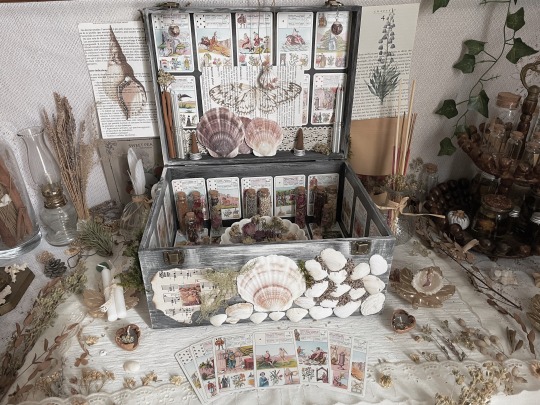
Apothecary Mlle Lenormand Altar set
Alienscty
#mlle lenormand#sea witch#water witch#divination#divinefemininity#divineenergy#altars#altar#aliensctyshop#alienscty#seashells#cartomancy#witchcraft#witches#witch#witchblr#vintage decor#floral#botanical#herbalism#Herbalist#spell candles
46 notes
·
View notes
Text
tagged by @bluehairandproverbs!
Rules: answer + tag 9 people you want to get to know better and/or catch up with
favorite color: red
last song: La Mano - Ghetto Kids
currently reading: mad ADHD so I read several books at once but one per category
fiction: Never Whistle at Night: An Indigenous Dark Fiction Anthology, 2023
non-fiction: Crows: Encounters with the Wise Guys of the Avian World, 2015, Candace Savage. not as good imo as Gifts of the Crow, but still a good time. I'm steadily working through all crow commercial nonfiction as part of our ongoing love affair with the babies. really i need to buy a supersoaker to discourage the hawks that are currently spooking the babies. by "spooking" I mean "trying to eat them." I have taken sides in this war. the gods play favorites and so do i.
technically this counts as work probably (writing or occult related): Fate, Fortune, and Mysticism in the Peruvian Amazon: The Septrionic Order and the Naipes Cards, 2011, Marlene Dobkin de Rios, Ph.D. I bought this for the included instructions on reading with la baraja española, but the author is just using the old French cartomancy rules attributed to Mlle Lenormand. But anyway, it's also a fascinating ethnographic peak into a neglected area and a neglected people, and I love that the author runs statistical analysis on the card system itself as well as her predictions. A lot of this will be familiar to anyone who's read cards for money, but it's awesome having math to back up how people misremember shit in your favor. ("You remember when you predicted xyz?" I did not predict xyz. "Yes you did! [client then repeats a completely unrelated thing you said about something else] See! That's what that means!" oh okay. thanks. sure. same time next week?) What is the Septrionic Order? idk I'm not at that part of the book yet.
currently watching: The Decameron
currently craving: those 90% dark chocolate squares that are delicious and I ate two a day for for like ten years straight but it turns out they're full of lead and cadmium
coffee or tea: coffee
tagging: jesus fucking christ NINE? i don't know nine people one of you tagged me in a nice one of these a while back and I meant to do it but I put it in my drafts and it is LOST FOREVER and I don't remember which one of you it was but please know I think of you fondly in the abstract and will think of you fondly specifically if you identity yourself.
otherwise, the usual suspects: @muffinbitch and @nanavn. plus @oldladynerd
@hueylewisandtheblues
@dixiedeadshake
@old-testament-bitch
@consideramove
@atomic0range
and you know, whoever. I'm trying to be more social on here. I don't remember anyone's name. I can spell maybe two of your handles off the top of my head and that's IT. I've known @nanavn for YEARS AND YEARS and it took me like five tries or rearranging the letters n and v and a before I got it.
21 notes
·
View notes
Text
What Does The Deck Say? April 3, 2024
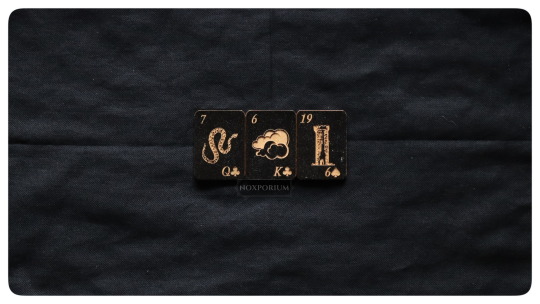
"The mixed signals you have been receiving about your promotion just got a lot cloudier. Trying to discern whether it is better to stay or to go is going to be difficult when the state of the industry itself is cast into doubt. Today, instead of trying to catch prevailing winds, focus on yourself and your immediate reach. Update your resumé, check your available funds, speak with someone you trust about your concerns. Either this is just a fast wind carrying nothing or the approaching edge of something substantial, but worrying yourself into nothing will not help either way."
The Tiny Timber Lenormand is a set of 36 etched birch tiles, each bearing the traditional number, playing card association, and a small image referencing the name of the card. Based on the Petit Lenormand system, itself named after Mlle. Marie Ann Lenormand (1772-1843), the small yet easy to read set allows for the use of all thirty-six tiles in a small space. The Tiny Timber Lenormand is ©Chas Bogan.
“What Does The Deck Say” is a weekday series of 3 card pulls from a cartomancy deck. No context or query is given to frame what the cards say as the posts are reading samples and not personal instruction. The result is sometimes humorous, sometimes serious, and usually surprising. All readers are invited to leave a comment about what they perceive in the random spread as each person will interact with the cards in their own way.
Personalized, direct, and private cartomancy readings are available via Ko-Fi: Noxporium.
5 notes
·
View notes
Text
La célèbre Mlle. Lenormand.
Description
Tools
Cite this
Main AuthorMarquiset, Alfred, 1867-Language(s)French PublishedParis, H. Champion, 1911.
SubjectsLe Normand, M. A. > Le Normand, M. A. / (Marie-Anne Adélaide), > Le Normand, M. A. / (Marie-Anne Adélaide), / 1772-1843.
Physical Description185 p. front., plate.
0 notes
Video
youtube
Part 1
Over the past several weeks we've looked at the history of Lenormand Tarot as its been told by Christopher Butler in the book accompanying this deck and a few quick online searches. The origins are as fuzzy as any other Tarot deck.
So far we've looked at a few single cards. The more I work with the deck, the more I appreciate the artwork. Color on black with a certain neon light at night aesthetic is my favorite palette. Been definitely feeling the intp, cyberpunk lofi aesthetic these days. This deck is a standout in the art and visual representation. I don't care much for the pale colors and deliberately old, eighteenth century look of most of the other decks that I've seen. The lesson there is to find a deck you resonate with VISUALLY regardless of RWS vs Lenormand setup to the deck.
See? We really are learning stuff here.
We also learned how the Lenormand Deck pushes you toward intuitive reading. You have to rely on your own intuition for the role that the playing card insets play in the card interpretation - if any. In contrast, the RWS decks use that aspect of intuition through card reversals. Lenormand disregards reversals outright.
I have to agree with my friends who said, in their experience, Lenormand tended to be more blunt, direct, in your face and to the point. I have a hunch that this is a function of Lenormand being a smaller deck and, I suspect, you might get the same punchy quality if you did a major arcana only reading with a RWS deck. Some limited run specialty decks are majors only, and when I first experiments with "cybertarot" software back in the 90s, the demo was majors only - and this has a similar feel to those majors-only readings. Just like when a lens narrows a beam of sunlight, it increases the heat and intensity of the light it could be that a smaller deck increase the intensity of a reading. But I also suspect there is a "goldilocks zone" at play, too. Too small of a deck, or too large of a layout could dilute or blur the cards' insights to the point that it is no longer useful at all.
In my experience, larger layouts will do that regardless of the deck's size. Even the 10 card celtic cross can get unwieldy and contradictory. I see no value in even trying the every-card-in -the-deck 4 x 9 grand tableau layout that is common to Lenormand. It is absurd to me on its face. My hunch is that Mlle Lenormand was riffing from pure intuition and using the cards to connect with her clients. That isn't to say that it is schtick or performance or a con or a trick...people are sometimes more willing to believe "the cards" over what another human has to say. The cards make us feel that the information is otherworldly, something more or special compared to human insight.
The cards are skeletal armature. The cards are a structural foundation on which human intuition builds.
That is the larger, functional insights from these cards today. Please read tomorrow and we'll take a look at these cards specifically in this pathway layout. The right hand card is fading energies, the middle card is current energies and the left card is growing energy as I read these.
continues tomorrow .....
0 notes
Video
undefined
tumblr
Lenormand-Karten sind ein beliebtes Wahrsagewerkzeug, das seit Jahrhunderten verwendet wird. Das Lenormand-Kartenspiel besteht aus 36 Karten und ist angeblich ein altes französisches Glücksspiel. In Wirklichkeit wurden diese Karten jedoch von einer Pariser Kartenlegerin namens Mlle. Marie Anne Adelaide Lenormand entworfen und von ihrem Sohn Jean-Baptiste nach ihrem Tod im Jahr 1843 veröffentlicht. Einführung in die […] Der Beitrag Lenormand-Kartenlesen: Liebe, Glück und mehr erschien zuerst auf Kartenlegen.blog .
0 notes
Text
O Baralho Cigano, foi criado pelos ciganos?

Vamos pensar na cultura dos ciganos: nômadas e ágrafa. Ou seja, eles deslocavam-se, viajavam o tempo todo, não tinham residência física, e também não registavam as suas histórias, a sua cultura em papel, era tudo verbal. Agora imagine que vai criar algo, neste caso, um oráculo, isso mesmo, você vai criar, ainda que não desenhe, você vai instruir o desenhista a partir das suas referências, da sua bagagem cultural, certo? Logo, não faz sentido o povo cigano criar um sistema simbólico utilizando, por exemplo, o emblema da casa (carta 4), do livro (carta 26) e da carta (carta 27), pois isso não fazia parte do cotidiano deles. Com base em tudo isto, então eu pergunto: como é que o "baralho cigano" pode ter sido criado pelos ciganos? Uma explicação plausível seria a utilização deste baralho em algumas religiões que cultuam as entidades ciganas (guias espirituais), e então começa um movimento de sincretismo relacionando cartas e orixás. Mas isso é só uma hipótese. Então de onde surgiu o "baralho cigano"? Surgiu em Nuremberg (Alemanha), no ano de 1798, como um jogo de tabuleiro, que poderia ser utilizado como entretenimento ou adivinhação. As cartas foram elaboradas por Johann Kaspar Hechtel com o nome "Jogo da Esperança", pois ganhava quem chegasse primeiro à casa da âncora (carta 35 e símbolo de esperança). Mas Hechtel morreu em 1800 e nem testemunhou o crescimento deste baralho. Foi então que, em 1845, que uma editora publicou o mundialmente conhecido Petit Lenormand, pois o nome baralho cigano é só fundido no Brasil, já falamos dessa hipótese anteriormente. Bem, e por quê esse título? Na França, existia uma cartomante muito conhecida, que atendia muitas personalidades, o seu nome era Marie Anne Adelaide Le Normand. A editora sabia disso e numa estratégia de marketing, (não era um termo da época, talvez golpe de mestre fosse mais apropriado), lançou o baralho Petit Lenormand com um livreto de instruções assinado por Philippe Lenormand, mas tudo indica ser um pseudônimo, mais marketing. Há boatos de que Mlle Le Normand usava este baralho nas suas consultas, mas não há evidências disso, até porque a célebre cartomante faleceu dois anos antes da criação do Petit Lenormand. Há registos também de que ela o teria criado, mas em nenhum dos seus livros publicados (sim, Mlle Le Normand também era escritora), há alguma referência isto. E por que ela não divulgaria o seu próprio Baralho, sendo uma cartomante reconhecida? Ela teria ganho mais fama e dinheiro. Então tudo isto reforça que ela não é a idealizadora, apenas usaram o seu nome. Avançando na história, o Petit Lenormand chega ao Brasil, em meados de 1856, seguindo as orientações tradicionais do livreto europeu e, aos poucos, começa a ser associado à religião, sofrendo mudanças de significados para ter correspondência com os orixás. Mas como vimos, a sua origem não ocorreu em nenhuma doutrina específica. A partir daí, surgem duas escolas para distinguir essas diferenças, a Escola Europeia com os significados tradicionais e a Escola Brasileira com o sincretismo. Qual é a melhor? Esse não é o ponto, o que importa é a mensagem que as cartas vão passar. O oráculo vai se apresentar de uma forma que a(o) oraculista consiga interpretar da melhor maneira, aquilo que a(o) consulente precisa saber sobre determinado assunto, independentemente da escola utilizada. Eu leio pela Escola Europeia, pois faz mais sentido para mim, mas é uma questão de escolha. Nos últimos anos, esse Baralho tornou-se o queridinho porque o seu protótipo (veja na imagem deste artigo) está exposto no Museu Britânico. Se tiver a oportunidade, faça uma visita, ainda que online. Fontes: Karla Souza, do Falando Lenormandês, e Alexsander Lepletier, do Lenormando. Taróloga Aurora A Equipa Chave Mística www.chavemistica.com
#Baralho Cigano#Le Petit Lenormand#Marie Anne Adelaide#Philippe Lenormand#Mlle Le Normand#Oráculos#Tarologos Online#Tarot#Cartomancia#Cartomantes Online#Chave Mística#Consultas Tarot
1 note
·
View note
Text

This the way the story ends, this is how it begins. Full analysis to come.
#lenormand#grand tableau lenormand#lenormand Oracle#tarotblr#gt Lenormand#mlle lenormand#Robert place Lenormand Oracle
3 notes
·
View notes
Link
An oldie but a goodie
#cartomancy#mediumship#psychic#18th century#fortune telling#lenormand#tarot#emanuel swedenborg#mlle lenormand
1 note
·
View note
Text
A new deck for the collection
A new deck for the collection

Marie Anne Adelaide Lenormand was a very popular fortune teller during the Napoleonic era, that became (in)famous when she became the card reader and confidante of Josephine, Napoleon Bonaparte’s wife. She was also arrested for espionage – and for witchcraft, but it was hard to make the accusation stick in post-Illuminist France. When she died she left a fortune to her only heir – that being a…
View On WordPress
0 notes
Photo
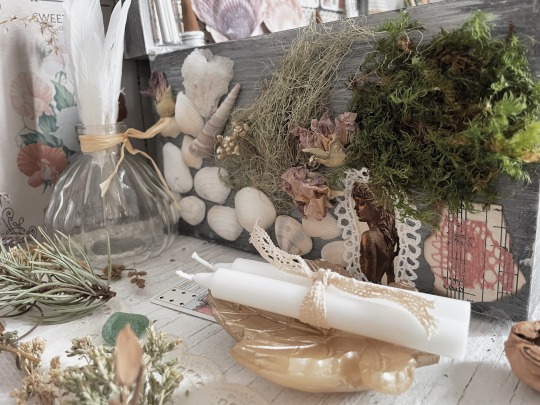

details of a custom order I just finished, inspired by a previous altar I curated ♡
#mlle lenormand#sea witch#water witch#divination#divinefemininity#divineenergy#altars#altar#aliensctyshop#alienscty#seashells#cartomancy#witchcraft#witches#witch#witchblr#vintage decor#floral#botanical#herbalism#Herbalist#spell candles
40 notes
·
View notes
Text
A Brief History of Tarot
I'm seeing a lot of questions about the origins of tarot going around again, so I suppose it's time to make a Post With Sources. Because from what I'm seeing, a lot of y'all are pulling from some bad information.
I've seen some of the discourse on tarot with regard to the decolonization discussion, but unfortunately, it often veers in the wrong direction. The discourse seems to focus on whether it should be a closed practice because of the Romani/Roma connection, but the origins of this idea are a misnomer.
Tarot cards originated in 15th-century Italy as perfectly mundane playing cards for a game called tarrocchi appropriati. Players would draw cards and use the thematic associations of the artwork to write short poems about each other. The cards were also used to play a trionfi or trumps style game similar to bridge.
The cards later became popular as fortune-telling devices in the 1780s. At this time, standard-suit playing cards (hearts, diamonds, clubs, and spades) were already being used for playful divinatory party games that were taken about as seriously as a middle school game of M.A.S.H.
Mystical origins for the pictures on the cards were first suggested by Antoine Court de Gébelin in 1781. The first official divinatory meanings were assigned to tarot cards by Jean-Baptiste Alliette in 1783. The deck was later revised by Mlle Marie-Anne Adelaide Lenormand, Jean-Baptiste Pitois, and Arthur Edward Waite of Rider-Waite fame to become the version we know today. The suit cards became the Minor Arcana and the trumps or wild cards became the Major Arcana.
From there, card-reading became a popular party game and tarot decks were indeed used by Romani/Roma people to tell fortunes. Since most people wouldn't hire them for "honest" work, they had to make money by busking, doing odd jobs, and trading on whatever skills they had, including knowledge of tarot cards and their "mystical" reputation. As mysticism and tarot decks faded from popular mundane use, the Romani/Roma people carried on using them. Eventually, this was the strongest...and only...association that remained in people's minds.
(And if you need an example of how quickly this can happen, just look at how long it's been since Rick Astley's biggest hit has been associated with anything other than internet memes.)
This supposition was only strengthened by the writings of modern occultists such as Éliphas Lévi (who reinforced Gebelin's claim of an Egyptian origin and introduced the idea of Hermetic Qabalistic associations; both ideas rooted in colonial exoticizing of other cultures), Raymond Buckland, and two of the three founding members of The Hermetic Order of the Golden Dawn. Aleister Crowley also wrote extensively about tarot and it's "ancient" mystical associations in his works and texts related to his self-created system Thelema, including the creation of the Thoth deck.
All of these ideas filtered down through modern pagan and New Age practices as part of the literature on the modern witchcraft movement, but so few authors bothered to look into the mundane history of the cards that their proper historical origins were often overlooked in favor of more mystical explanations. Yes, including their supposed genesis among the Romani/Roma, and all the superstitions pertaining thereto, i.e. your first deck must be a gift, and so on.
In short, cartomancy through tarot is an open practice, the tarot cards themselves are mundane objects that originated on gaming tables, it was never exclusive to one group or tradition, and the only reason we think it first came from some secret sacred practice of the Romani/Roma is because the scholarship that the New Age movement pulled from for their ideas on tarot was done by a whole lot of Western White Guys with imperialist mindsets. (The reductive/racist thought process of the day was basically, "Well, the Romani/Roma allegedly come from Egypt, and Gebelin said the card designs do too, so there it is!")
I also encourage reading of the Wikipedia articles on Tarot and Tarot-Reading, and the Encyclopaedia Britannica article on the same. I know these aren't the end-all-be-all of resources, but they do trace the history of the cards and the parties involved with the changing conversation on their design, origins, and deeper meaning. It's worth noting that many texts discussing late 19th-century occultism are now in the public domain and can be found on Project Gutenberg, if you're interested in seeing how ideas and views about tarot progressed over time in the words of the occult scholars themselves.
It's also worth noting that scholarly speculation on the supposed origins of a practice do not always constitute historical fact, no matter how often they're repeated. (See also: Bede and Eostre.)
So what does this mean for modern tarot users?
It means if you like a deck, you don't have to wait for someone to gift it to you. It means you're not stealing anything if you read tarot, even if you ask to be paid for your readings. It means bad information disseminates faster and more easily than good information, largely because it's shorter and easier to fit into performative agendas. And it means we still need to do our homework when it comes to the history of witchcraft.
#witchcraft#witchblr#tarot#divination#I am FULLY prepared for backlash on this one and I've got my receipts.
854 notes
·
View notes
Text
What Does The Deck Say? May 31, 2023
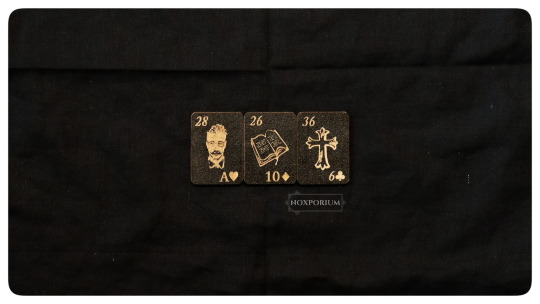
Short Reading: "The cost of coming through is the loss of ignorance. This will not be without pain. How bad do you want to come through?"
Not So Short Reading:
"You always wanted to know more about yourself, but you didn’t want to find out the Hard Way™. But the Hard Way™ is the only way you’re going to learn what you need to keep yourself going when no one else is there for you."
The Tiny Timber Lenormand is a set of 36 etched birch tiles, each bearing the traditional number, playing card association, and a small image referencing the name of the card. Based on the Petit Lenormand system, itself named after Mlle. Marie Ann Lenormand (1772-1843), the small yet easy to read set allows for the use of all thirty-six tiles in a small space. The Tiny Timber Lenormand is ©Chas Bogan.
“What Does The Deck Say” is a weekday series of 3 card pulls from a cartomancy deck. No context or query is given to frame what the cards say as the posts are reading samples and not personal instruction. The result is sometimes humorous, sometimes serious, and usually surprising. All readers are invited to leave a comment about what they perceive in the random spread as each person will interact with the cards in their own way.
Personalized, direct, and private cartomancy readings are available via Ko-Fi: Noxporium.
10 notes
·
View notes
Text
Baralho Cigano ou Petit Lenormand e sua origem

O Baralho Cigano, e sua origem, sempre foram envoltos de mistérios, e de tempos em tempos aparecem novas informações históricas sobre o seu surgimento.
Até pouco tempo atrás, acreditava-se que a origem do Baralho Cigano era marcada pelo uso destas cartas pelo povo Cigano e que uma das videntes francesas mais conhecidas da época, Marie-Anne Adélaïde Lenormand, ou somente Mademoiselle Lenormand, certo dia andando pelas, ruas teria visto alguns ciganos lendo a sorte para as pessoas através de algumas cartas. Muito curiosa se aproximou e pediu a eles se eles poderiam ensiná-la e se lhe dariam a permissão de usar este Baralho Cigano. Depois de uma visita ao clã, e após falar com os mais velhos, a permissão lhe foi dada pelos ciganos.
O Petit Lenormand foi lançado em 1846, após a morte de Mlle. Lenormand, Phillippe Lenormand, que se auto-intitulava seu sobrinho.
Junto com o jogo, havia um livreto, escrito por Phillipe Lenormand, que explicavam como as cartas deveriam ser usadas como oráculo.
Read the full article
#"LesAmusementsdesAllemandsorDiversionsoftheCourtofVienna#Âncora(9deEspadas)#Anel(ÁsdePaus)#Árvore(7deCopas)#baralhocigano#baralhociganolenormand#baralholenormand#Buquê(RainhadeEspadas)#Caminhos(RainhadeOuros)#Carta(7deEspadas)#Chicotes(ValetedePaus)#Coração(ValetedeCopas)#Corujas(7deOuros)#DasSpielderHoffnung#Jardim(8deEspadas)#JohannKasparHechtel#lenormand#Marie-AnneAdélaïdeLenormand#MaryK.Greer#mlle.lenormand#OjogodaEsperança#origemdobaralhocigano#orimystyco#Peixes(ReideOuros)#PhillippeLenormand#Serpente(RainhadePaus)#TaliGoodwin#Trevo(6deOuros)#Urso(10dePaus)
1 note
·
View note
Note
Uhm... I tried googling this but came out empty, and since you are taking questions, I'll provide. Which is the difference beyond... Own preference, between lenormand and Marseille tarot cards for divination? I might be saying some awfully wrong things but cards are not my thing exactly.
Oh dear, this question may be approached from at least three angles that I can think of immediately.
First of all, there is a technical difference between the tarot and lenormand system in general. A tarot deck is one consisting of five suits: Major Arcana, which is the twenty-two archetypes or symbolic characters, and Wands, Coins, Swords, and Cups, originated in Renaissance Italy. A Marseilles tarot deck is one where the pips are not fully illustrated, and instead depict a number of items of the respective suit. Now, despite the association with playing cards, a lenormand pack as such does not have suits. What it does have is thirty-six symbolic images derived from popular a few hundred years ago Game of Hope: as the game went out of fashion, the deck was republished and marketed mostly for divination, which is where, in all likelihood, it takes its association with Mlle. Lenormand. The Primal Lenormand, a deck that is available now and which I have the pleasure to own, is a reprinting of the first known deck of the lenormand type, still at the time, in 1799, generally used for leisurely games - the images contain, alongside the pictures of Flowers, Clover, Mice, Bear, Cross, the Rider, and so forth, two types of playing cards, making it possible to entertain oneself with games that require them.
Second, looking into purely playing card divination, I find that, despite the division into suits, the traditional meanings have little to do with the tarot. It is an oracle in itself, promising long, late night journeys, drinking, and visits to wealthy homes. Simply put, it is a different system that was - and is, - used mostly for the purposes of old-fashioned fortune telling. If I may be shameless for the purposes of education, I recently created a post providing some of the interpretations in question, noting, for the sake of comparison, the appropriate lenormand cards, which do differ; the list is to be followed by the rest shortly.
Lastly, in my experience, while both may be used for just about anything, lenormand cards work best with events, thoughts, and actions - the observable surface and worldly happenings. The tarot as presented in the current day rather tends towards deeper motivations and tendencies, as well as their reflections in the world around.
I hope this answers your question.
31 notes
·
View notes
Text
Lenormand Oracle Decks
Hello my friends, are you having a good day?
I have been playing around with some cards this morning and felt like sharing!
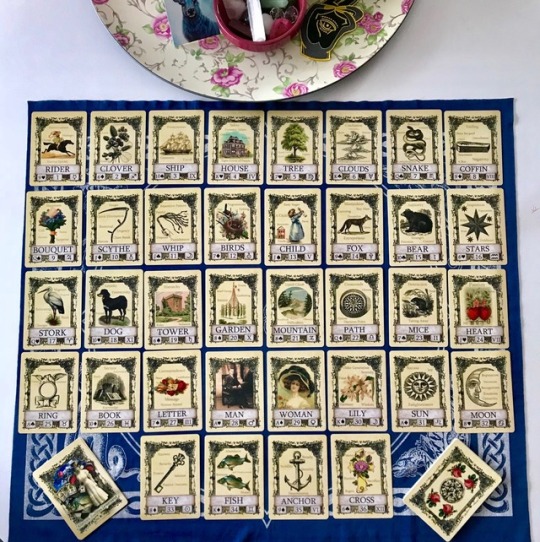
With the popularity of Lenormand Oracle decks on the rise, I thought it might be good to have a closer look at this branch of divination cards.
I will give you a little history first (I am no expert though! Feel free to do your own research!):
When we talk about Lenormand cards we immediately connect them to Mademoiselle Le Normand, the French Fortune Teller who was famous as "Divinatrix to the Stars" in the first half of the 1800’s.
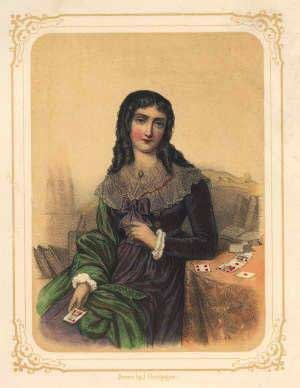
However, it is my understanding that Marie Anne Adelaide Le Normand was not actually the creator of this divination-system.
It is true that she was a very accomplished diviner, reading coffee-grounds and egg-whites, practising Cartomancy and Palmistry, Numerology, Scrying and Necromancy amongst others! But as far as I know, she used playing cards for her readings, not the cards we have come to know as Lenormand...
The naming of these cards seems to have more to do with 19th century publishers wanting to profit from Mademoiselle Le Normand’s fame - she had written around 14 books about her readings for- and dealings with- her famous (and infamous) contempories, including Robespierre and Empress Josephine! She was also believed to have predicted the rise and fall of Napoleon’s empire.
I think that it was later discovered that many of her accounts described in her books were, at the very least, exaggerated!
If you want to know more about the possible origens of today’s Lenormand Oracles, I suggest you turn to the experts who will be able to tell you so much more than I could: Mary K. Greer for one has done some excellent research I believe, as has Robert M. Place. I am sure there have been many others!
Now a little bit about the deck itself:
The first deck to have emerged with The Le Normand name attached was Le Grand Jeu de Mlle Lenormand, published 2 years after her death - this set consisted of 54 cards (52 related to normal playing cards plus 2 significators). My knowledge of this deck is severely lacking, hence I will move on to the most popular Lenormand Oracle that we use today.
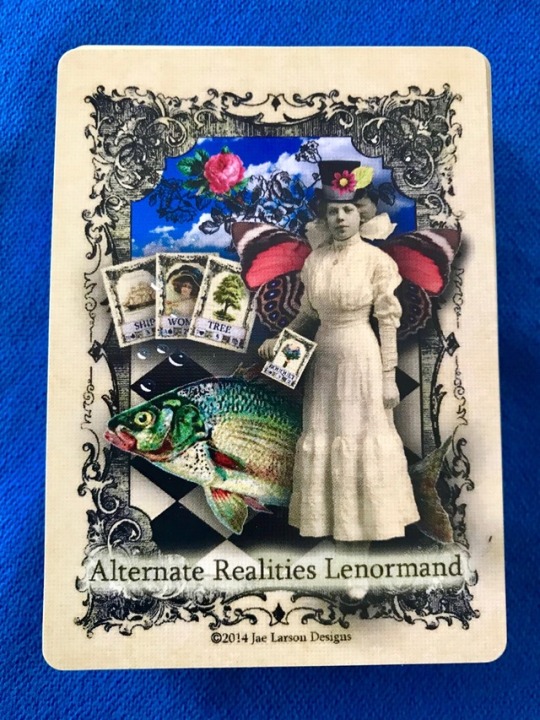
The Petit Lenormand is a 36 card oracle deck first published in 1846 in Germany and it was very different from the earlier French decks. This is the deck that modern Lenormand cards are based on.
The cards depict the following images:
1. The Rider
2. The Clover
3. The Ship
4. The House
5. The Tree
6. The Clouds
7. The Snake
8. The Coffin
9. The Bouquet
10. The Scythe
11. The Whip
12. The Birds
13. The Child
14. The Fox
15. The Bear
16. The Stars
17. The Stork
18. The Dog
19. The Tower
20. The Garden
21. The Mountain
22. The Path
23. The Mice
24. The Heart
25. The Ring
26. The Book
27. The Letter
28. The Man
29. The Woman
30. The Lily
31. The Sun
32. The Moon
33. The Key
34. The Fish
35. The Anchor
36. The Cross
A lot of decks (but not some of the more modern ones) also display a small playing card, or at least a particular suit of playing cards (hearts, clubs, diamonds and spades) - there are also decks that have an extra symbol relating to astrology.
You can use these decks on many different levels, from only working with the main imagery to including numerology and/or astrology.
Many of todays decks also include extra cards (from extra men and women to yes/no cards or to complete the full 52 playing card decks).
The main classic Lenormand Spreads used are the 3 - 5 or 9 card spreads or the Grand Tableau - which incorporates all 36 cards in a lay-out consisting of 4 rows of 8 cards each and one row of 4 cards. The cards are read according to their position in the spread.
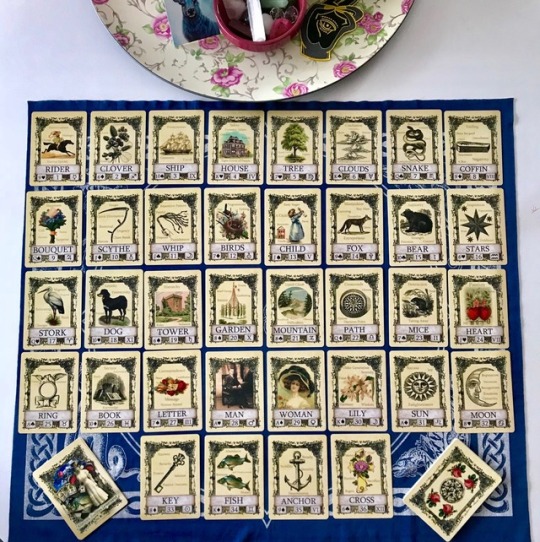
Of course you could just draw one or two cards if you want, there are also more modern Lenormand spreads available on top of the classics.
Although some of the cards found in a Lenormand deck also occur in a Tarot deck, I find that with Lenormand you take the cards more at face-value and the layering of interpretations does not go quite as deep as with Tarot.
The main similar cards are The Sun, The Moon, The Stars and The Tower (note the Tower is still standing here!) - but The Scythe could be related to the Death card in Tarot whilst The Heart card is easily connected to The Lovers.

Other cards such as The Dog may not occur in Tarot, but because of it’s rich imagery and symbolism the meaning may be recognisable to those familiar with (in the example of The Dog) The Fool card, where often a faithful little dog is seen nipping at his master’s heels.

This dog can also be found in tarot’s Moon card, alongside the wolf/fox/coyote often used to depict our “wild” side - Lenormand’s Fox may be related to this image as well.
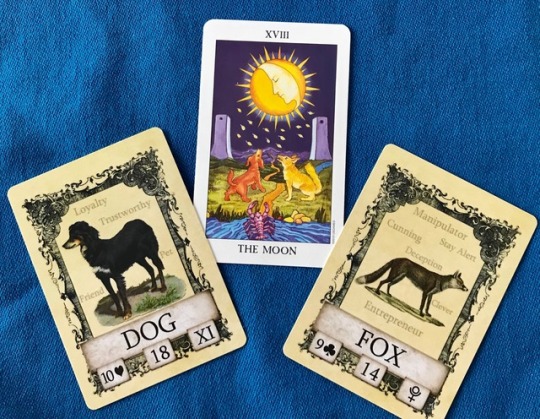
Personally I prefer my Lenormand deck to have small-sized cards, you would need a massive table to complete a Grand Tableau if you have oversized cards!
Some of my favourite decks are: The Dreaming Way Lenormand; The Claire de Lune Lenormand; Ciro Marchetti’s Gilded Reverie Lenormand and The Scrying Ink Petit Lenormand.
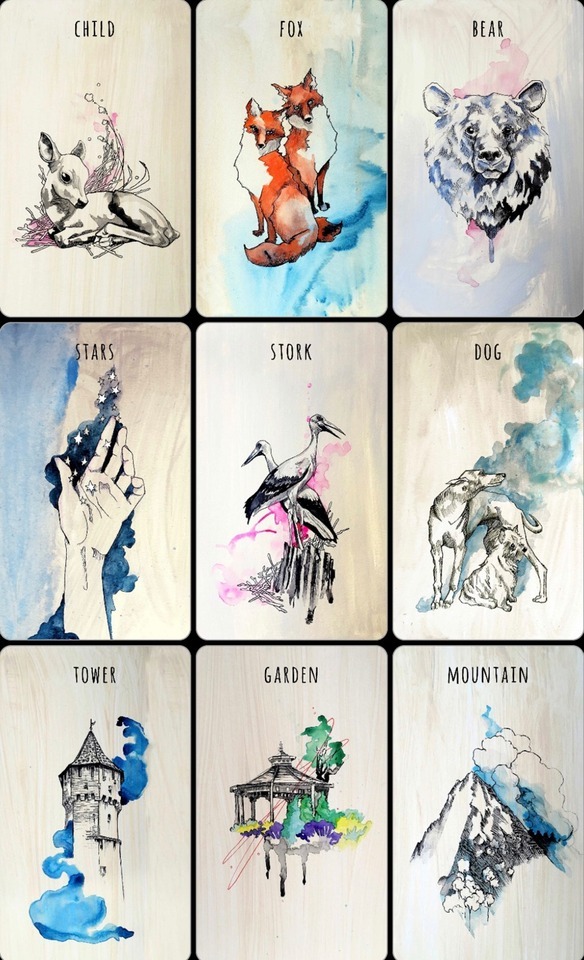
The latter is currently sold out but will hopefully be reprinted and in the mean time you can still enjoy it digitally by downloading the app, which will give you access to all of it’s beautiful watercolour images, the card interpretations and several spreads!
I find these apps from The Fool’s Dog very useful by the way, if you are unsure wether or not a particular Tarot or Lenormand deck is for you, then you can get to know it at a very reasonable price before committing to buying an actual deck.
The deck I was using this morning was the Alternate Realities Lenormand by Jae Larson Designs.
This is an oldfashioned-style deck that has the added benefit of having “cheat-words” printed unobtrusively in the background - very useful if you haven’t mastered the Lenormand system yet but want to start doing spreads without constantly referring to a guidebook!

I hope you found some of this explanation interesting or useful!
Much Love,
Xxx
#lenormand oracle#divination#cartomancy#Mademoiselle Le Normand#Scrying Ink#Alternate Realities Lenormand
20 notes
·
View notes